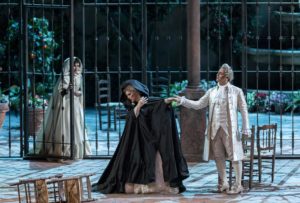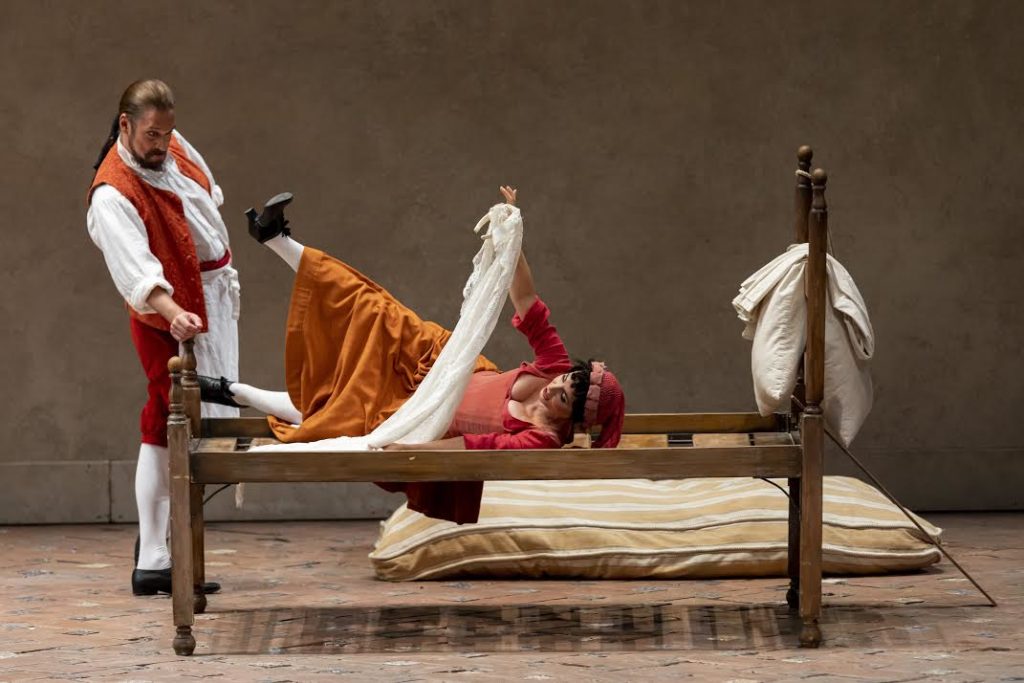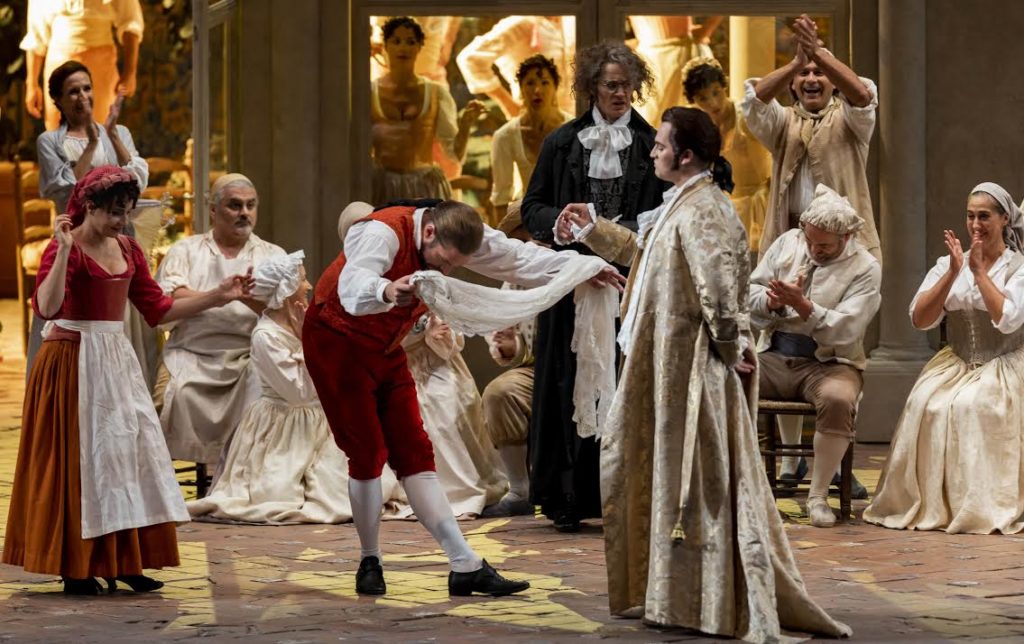
Palau de Les Arts 2019-20 Review: Le Nozze di Figaro
A Fantastic, But Inaudible, Cast Is Overpowered By The Orchestra
By Mauricio Villa(Credit: Mikel Ponce)
The Teatre de Les Arts opened his season on the 27th of September with “Le Nozze di Figaro” by Mozart.
The famed composer’s music is performed quite often at all levels of the opera world, but it does not by any means make it easy to sing. The Mozartian style demands purity of the line, clean attack of the notes (you can not use appogiature or portamenti) and the voices are usually exposed when the operas are played with chamber orchestras as was in Mozart’s time. Singers agree that Mozart teaches you to sing, and that if you dominate Mozart you can sing everything. It is a pity that singers, unless the specialized, begin their careers singing Mozart’s operas but abandon them moving to heavier repertoire as the voice develops; only a few singers manage to keep Mozart’s titles throughout their whole careers.
Hyper Realism Takes Hold
Prolific Spanish stage director Emilio Sagi and his team, which included Daniel Banco and Renata Schussheim designing the sets and the costumes respectively, chose to make a hyper realistic production. It was, in many ways, a relief to see an opera staged in its intended period, with proper naturalism, but at the same time evocative sets and luxury costumes under the eyes of a modern director who paid attention to every single word in service of creating dynamic scenes.
It is a production that smells of Sevilla, with the typical Sevillian courtyards with orange trees, walls with autochthonous tilling, flamenco movements, and fandango dance, and a splendid Sevillian garden with a monumental fountain pouring out real water that smelled of jasmine. It is very sensual and erotic at moments, as well as hilarious and comical. The production premiered at Teatro Real in 2009 and has been often revived in several theatres. Despite of being 10 years old it seems as fresh and new as the first day.
All the sets have an amazing depth with Sagi having something going on in both the foreground and background of the set. Even so, he never distracts from the main action, but uses the background events to color the scene.
For example, during first act we always see the characters appearing in the courtyard, interacting with the servants or even peering from the windows into Figaro’s chamber before entering the scene. The characters are always in constant motion, nothing is left out. Susanna imitates a bull before jumping into the bed with Figaro at the end of their first duet “Cinque…dieci.” Marcellina rejoices in Figaro’s bed while Bartolo sings “La vendetta, oh, la vendetta.” In another instance, Susana pretends to be a bullfighter using an apron with Cherubino playing the bull during “Venite inginocchiatevi.”
Such actions, among many others reinforce the comedy of the opera. At the start of Act two, Susana opens the window blind of the countess’s bedroom to let the sunshine in; the effect is sublime and breathtaking. There is a ballet dancing the Fandango in Act three and even the countess, Susana and Figaro join the dance at some point.
In Act four there is a fence with three doors separating the fountain and back wall of the garden from the center of the stage. It is all abundantly decorated with vegetation and lots of wooden chairs in several positions that will play an evocative role in the action. There is the moon which is partly hidden behind trees that moves during the act.
If I should describe this production in three words it would be: beautiful, sensual and comical.

(Credit: Mikel Ponce)
Not Quite On The Same Level
The vocal cast was sadly not at the same level, although they were very good singers that gave solid stylistic and emotional performances. However, you could barely hear them as they were often overpowered by the orchestra.
We must take three factors into consideration: The projections of the voices, the volume of the orchestra and the number of musicians playing at the pit. This is all on conductor Christopher Moulds, who undeniably should have had a pulse on the balance between the voices and the larger ensemble; in this case, he clearly did not.
Maria Jose Moreno, a Spanish lirica-leggera soprano, was the absolute triumphant of the night as the Countess. Singing a role which did not adequate to her vocalita for its central tessitura, she interpreted the role with her beautiful timbre and a solid projection from the lower to the higher register.
This character has the two most lyrical arias of the opera (“Porgi amor” in Act two and “Dove sonno” in Act three), which Moreno sang with delicacy, a clean line and breath support, and melancholic mood. She rose in two chromatic scales to two sweet and sustained high Cs during the terzeto in Act two, the coloratura solid. Her interpretation of the phrase “Più docile sono, e dico di sì…” was hair-raising.
She played the role with aristocratic manner and comical attitude when needed (such as when the Count is interrogating Figaro during the end of Act two) proving to be a wonderful actress as well. She received the greatest ovation of the night at the curtain call.
Spanish soprano Sabina Puértolas took the role of Susanna, Figaro’s fiancée. The soprano gave Susanna a dark-colored timbre, but her voice seemed small in the central tessitura of the role. Mozart demands some low notes, like a low C even several low A naturals in the septet that closes Act two or during one recitative in Act four. Puértolas was not comfortable on those notes, but the problem was that her voice did not project her voice often disappeared during the performance. She was fantastic during her two arias, “Venite inginochiatevi” and “Deh vieni non tardar” where the orchestra is playing soft and her voice, always perfect in pitch and style.
Sparring Men
The title role of Figaro was entrusted to the Canadian Bass-baritone Robert Gleadow, who again, despite possessing a powerfully dark instrument, could not surpass the sound of the orchestra and decided to do all the high F’s of the score with falsetto sound rather than pianissimo.
In Mozart’s time there were no specification for the lower voices which were always classified as basses (female voices were only classified as sopranos) always depending on the qualities of the singer Mozart was writing for. Despite the high notes and the insistency on High E flats during his las aria “Aprite un po’ quegl’occhi” the tessitura is quite central or even low, which leaves low voices uncomfortable on the high notes and most baritones awkwardly positioned on the lower ones. Gleadow proved to be a superb Mozartian singer, with a depurate Italian diction (needed for the fast recitative), clean vocal line and attack of the notes.
Andrzej Filonczyk portrayed the role of the Count with dignity and integrity, possessing a splendid lyrical voice, though showing some difficulties in the roulades of his aria “Hai già vinta la causa,” where he pushed some notes in the coloratura to uneven results. But he ended his aria with a perfect attack of the high F sharp, something not easy to do.
His interpretation of “Contessa, perdono,” probably the most beautiful line Mozart wrote in opera, was gloriously delivered. The baritone managed to surpass the already mentioned problem of the orchestra, but was not as present as Moreno’s voice. His characterization of the role was too rigid and aristocratic, missing lots of comedy situations.

(Credit: Mikel Ponce)
Flexible & Unique Voices Among Supporting Cast
Cherubino was sung by the mezzo-soprano Cecilia Molinari with a flexible sweet timbre and good projection. The interpretation of her two arias, “Non si più cosa son” and “Voi che sapete,” were excellent. And her characterization of the lascivious teenager who is in love with every woman at the palace was hilarious, comical and proved her physical abilities to jump, run, and roll over on the stage. She was one of the few members of the cast whose voice projected over the orchestra.
The magnificent Colombian bass-baritone Valeriano Lanchas took on the role of Bartolo, whose part is reduced to a single aria “La vendetta, si, la vendetta” and a few solo phrases during recitatives and ensembles. He has a tremendously big voice with a round timbre, which gave him some trouble during the fast parlatto moment. However, he compensated with his comical acting and gorgeous voice.
Lyrical soprano Susana Cordón sang the role of Marcellina. She delivered a cartoony characterization of Marcellina, but remained believable and humorous all the same. Vocally, her aria “Il capro e la capretta” showed off her fluid coloratura, as she reached high A and B naturals in several scales with great ease.
I have to mention the brief appearance by Joel Willams as Basilio, as his aria from act four was cut and his part was reduced to a Terzeto in Act one and ensemble moments. As with Cordón, this young tenor created a humorous creation and, above all, his voice was projected wonderfully, proving once more that projection is more important than volume.
When the premiere of “Le Nozze di Figaro” took place in Vienna in 1876, the same singer doubled the characters of Basilio and Don Curzio, and the same bass doubled Basilio and Antonio. This is rarely done today, so Les arts counted on José Manuel Montero as Don Curzio, Felipe Bou as Antonio, and Vittoriana De Amicis as Barbarina. All did a solid job.
Christopher Moulds, who is an expert conductor in the Classical and baroque repertoire, appeared at Valencia for the very first time and dominated the titular orchestra with supremacy, extracting all the chiaroscuros from the score and bringing out a pure Mozartian style. As noted, he should have found a better balance between the orchestra and the voices, as the larger ensemble wound up being the real protagonist of the evening. The Cor de la Generalitat Valenciana sounded round and together during the few interventions that this opera demands.
It was a great season opening with a splendid production with a solid cast. However, the orchestra’s power and overall lack of balance left a lot to be desired.



